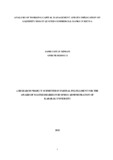ANALYSIS OF WORKING CAPITAL MANAGEMENT AND ITS IMPLICATION ON LIQUIDITY RISK IN QUOTED COMMERCIAL BANKS IN KENYA
Abstract
Working capital management involves planning and controlling current assets and current
liabilities in a manner that eliminates the risk of inability to meet due short term obligations on
the one hand and avoid excessive investment in these assets. Liquidity refers to banks’ ability
to fund increase in assets and meet obligations as they fall due. The general objective of this
study was to establish the implications of working capital management on liquidity risk of
Nairobi securities exchange (NSE) quoted commercial banks in Kenya. This study used a
longitudinal research design because it involved taking repetitive measures overtime for the
purpose of comparing returns over the periods. The target population was made up of all the 9
NSE quoted commercial banks in Kenya; this was over a period of 10 years from 2002 to
2011. The data was collected from secondary sources; these were published financial
statements available at banking survey of Kenya. The descriptive statistics such as mean and
standard deviation were used to measure variations. Statistical inferences were drawn using
correlation and regression analysis in analyzing the data and testing of hypotheses. Analyzed
data was presented using frequency tables and graphs. The key findings from the study are:
debtors’ collection period and cash conversion cycle have significantly negative relationship
with liquidity of quoted commercial banks; this means that more liquid banks take the shortest
time to collect cash from their customers. Creditors’ payment period have significantly positive
relationship with liquidity of quoted commercial banks in Kenya, this implies that the longer
the bank takes to pay its creditors, the more liquid it is. The research recommends that the NSE
commercial banks should maintain their current assets for meeting their short term obligation
thereby increase their liquidity by shortening their debtors’ collection period and cash
conversion cycle whereas increasing their creditors’ payment period for better liquidity
position. Findings of this study add to knowledge and understanding of the subject of working
capital management and its implication on liquidity risk on NSE quoted commercial banks.
Also, the study yields information that may be useful for proper planning and decision making
at the commercial banks.

